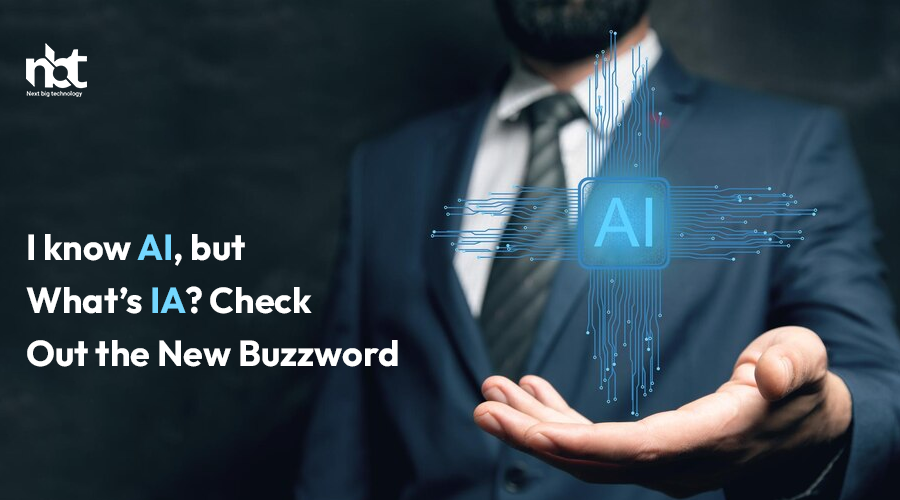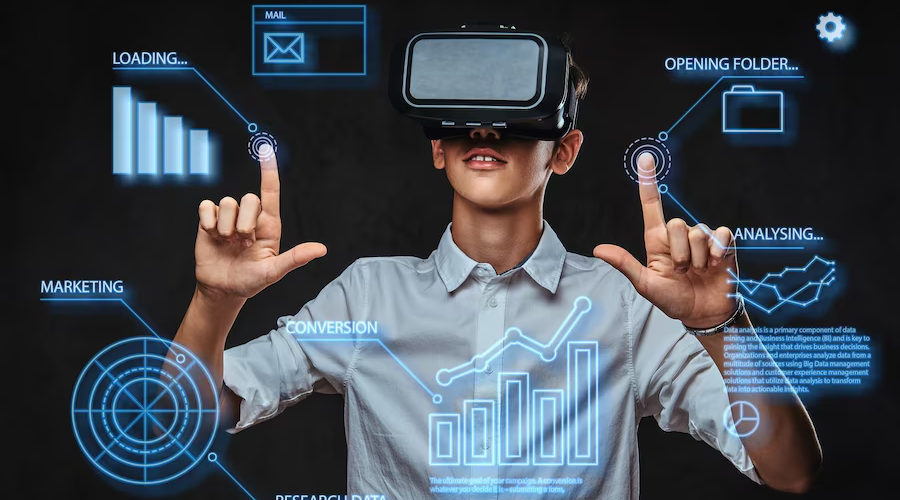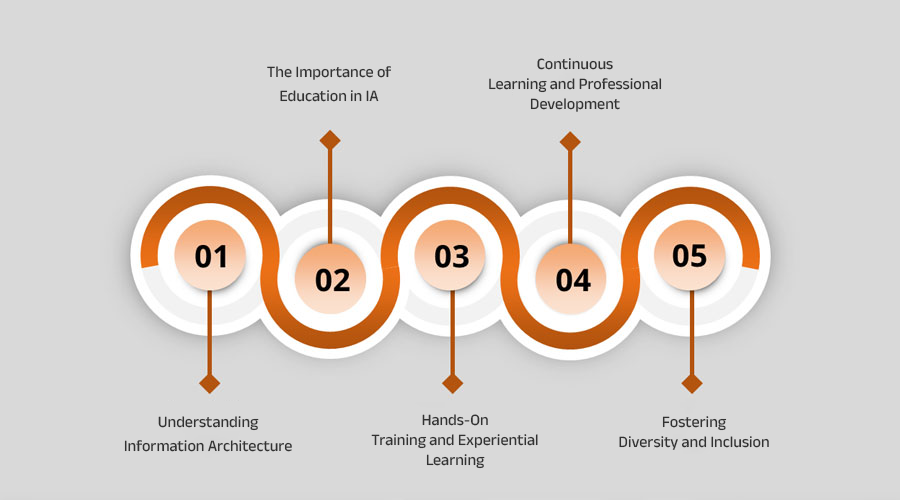Table of Contents
Introduction to IA: Understanding the Concept Beyond AI
In the ever-evolving landscape of technology, two acronyms dominate conversations: AI and IA. While AI, or Artificial Intelligence, has garnered substantial attention and headlines, its counterpart, IA, or Intelligence Augmentation, often remains in the shadows. However, understanding IA is crucial in comprehending the broader spectrum of technological advancements and their impacts on our lives.
The Genesis of IA: IA emerged as a concept in the 1950s, alongside the inception of AI. However, unlike AI, which focuses on replicating human-like intelligence through machines, IA aims to enhance human intelligence through technological means. Simply put, while AI seeks to create intelligent machines, IA strives to create intelligent humans, empowered by technology.
Beyond Automation: One of the key distinctions between AI and IA lies in their objectives. AI primarily focuses on automating tasks, aiming to replace or replicate human capabilities. On the other hand, IA emphasizes collaboration between humans and machines to amplify cognitive abilities, improve decision-making, and enhance overall performance.
Applications Across Industries: The realm of IA extends far beyond traditional AI applications. In healthcare, IA facilitates diagnosis and treatment by providing doctors with comprehensive insights and data analysis tools. In education, IA personalizes learning experiences, catering to the individual needs and preferences of students. Similarly, in business, IA optimizes processes, augments human decision-making, and unlocks new opportunities for innovation and growth.
The Human-Centric Approach: Unlike AI, which sometimes evokes concerns about job displacement and autonomy, IA places humans at the center of technological advancement. Instead of replacing humans, IA complements their skills and capabilities, empowering them to achieve more and excel in their respective domains. This human-centric approach fosters collaboration, creativity, and continuous learning, driving progress and prosperity for society as a whole.
Ethical Considerations: As with any technological advancement, the rise of IA raises important ethical considerations. Issues such as data privacy, algorithmic bias, and accountability come to the forefront when integrating IA into various aspects of our lives. It is imperative to ensure that IA systems are developed and deployed responsibly, with careful consideration of their societal impacts and ethical implications.
The Future of IA: As we venture further into the era of digital transformation, the significance of IA will continue to grow. From healthcare and education to finance and entertainment, IA will reshape industries, redefine professions, and revolutionize the way we live and work. Embracing IA opens doors to endless possibilities, empowering individuals and organizations to thrive in an increasingly complex and interconnected world.
Differentiating AI and IA: Unveiling the Nuances
In the realm of technology, two terms frequently intermingle yet harbor distinct connotations: Artificial Intelligence (AI) and Intelligence Augmentation (IA). While both concepts revolve around enhancing human capabilities, they diverge significantly in their approaches and implications. Understanding these nuances is pivotal in navigating the evolving landscape of technology. Let’s delve deeper into the realms of AI and IA to unveil their subtle disparities.
The Essence of Artificial Intelligence (AI)
AI, often portrayed in sci-fi as sentient machines, encapsulates the simulation of human intelligence by machines. This involves the development of algorithms and systems that can mimic cognitive functions like learning, problem-solving, and decision-making. AI endeavors to imbue machines with autonomy, enabling them to adapt to various scenarios without explicit programming.
In essence, AI operates on the principle of “thinking” machines, capable of processing vast amounts of data, recognizing patterns, and making predictions. From self-driving cars to virtual assistants like Siri and Alexa, AI permeates numerous facets of modern life, revolutionizing industries and reshaping societal paradigms.
Intelligence Augmentation (IA): Elevating Human Capabilities
On the other hand, IA, often overshadowed by its counterpart, focuses on empowering human intellect rather than substituting it. Unlike AI, which emphasizes machine autonomy, IA aims to amplify human intelligence by leveraging technology as a tool for augmentation. It entails integrating technology seamlessly into human activities to enhance cognitive abilities, productivity, and decision-making processes.
Rather than replacing human functions, IA supplements them, facilitating tasks that would otherwise be arduous or impossible. Examples of IA abound in everyday life, from basic calculators to complex data analytics software used in business intelligence. In essence, IA embodies the symbiotic relationship between humans and technology, wherein each complements the other’s strengths and compensates for weaknesses.
Key Differentiators
Understanding the disparities between AI and IA is crucial for grasping their distinct roles and implications:
- Autonomy vs. Collaboration: AI operates autonomously, whereas IA collaborates with humans, enhancing their capabilities.
- Emulation vs. Amplification: AI emulates human intelligence, while IA augments it through technological integration.
- End Goal: The ultimate aim of AI is machine autonomy and decision-making, whereas IA aims to enhance human productivity and problem-solving abilities.
Navigating the Future
As AI and IA continue to evolve, discerning their nuances becomes imperative for harnessing their potential effectively. While AI promises groundbreaking advancements in automation and predictive capabilities, IA fosters a synergistic relationship between humans and technology, unlocking new avenues for innovation and creativity.
The Evolution of IA: From Concept to Implementation
In the ever-evolving landscape of technology, intelligent automation (IA) stands out as a transformative force, reshaping industries and revolutionizing how businesses operate. From its conceptualization to its widespread implementation across various sectors, the journey of IA is marked by innovation, collaboration, and continuous advancement.
Conceptualization of Intelligent Automation: The seeds of intelligent automation were sown with the convergence of artificial intelligence (AI) and automation technologies. It emerged as a response to the growing need for efficient and scalable solutions to handle complex tasks traditionally performed by humans. The concept envisioned systems capable of learning from data, making decisions, and executing tasks with minimal human intervention.
The initial stages saw the development of rule-based systems and basic machine learning algorithms that laid the foundation for more sophisticated IA solutions. Researchers and innovators delved into areas such as natural language processing, computer vision, and cognitive computing, exploring ways to imbue machines with human-like intelligence.
Implementation Across Industries: As IA technologies matured, businesses began to recognize their potential to drive operational efficiencies, enhance customer experiences, and unlock new opportunities for growth. Implementation of IA solutions gained momentum across a diverse range of industries, including finance, healthcare, manufacturing, and retail.
In finance, IA found applications in algorithmic trading, fraud detection, and risk management, enabling organizations to make data-driven decisions in real-time. In healthcare, IA-powered systems revolutionized patient care through predictive analytics, personalized treatment plans, and medical image analysis.
Manufacturing witnessed the rise of smart factories equipped with IA-driven robotics, IoT sensors, and predictive maintenance algorithms, optimizing production processes and minimizing downtime. Retailers leveraged IA for demand forecasting, inventory management, and personalized marketing campaigns, driving sales and improving customer satisfaction.
Continuous Advancement and Future Outlook: The evolution of IA continues unabated, fueled by advancements in AI, machine learning, and robotic process automation (RPA). Breakthroughs in deep learning, reinforcement learning, and explainable AI are expanding the capabilities of intelligent systems, enabling them to handle increasingly complex tasks with human-like reasoning.
The integration of IA with emerging technologies such as blockchain, edge computing, and quantum computing holds the promise of unlocking new frontiers in automation. From autonomous vehicles and smart cities to personalized healthcare and AI-driven creativity, the possibilities are limitless.
However, as IA becomes more pervasive, it also raises ethical, societal, and regulatory considerations. Concerns around data privacy, algorithmic bias, and job displacement necessitate careful deliberation and responsible deployment of IA technologies.
Enhancing Human Intelligence: Exploring the Role of IA
In the ever-evolving landscape of technology, the quest to enhance human intelligence has been a driving force. From the advent of the wheel to the emergence of artificial intelligence (AI), humanity has always sought ways to augment its cognitive abilities. However, amidst this pursuit, a lesser-known yet profoundly impactful concept has emerged: Intelligence Augmentation (IA). In this article, we delve into the depths of IA and explore its transformative role in enhancing human intelligence.
Understanding Intelligence Augmentation (IA)
Intelligence Augmentation, often abbreviated as IA, represents a symbiotic relationship between humans and machines. Unlike Artificial Intelligence, which aims to replicate human intelligence through algorithms and data processing, IA focuses on amplifying human cognitive abilities by leveraging technological advancements.
At its core, IA seeks to complement human intelligence rather than replace it. It recognizes the unique strengths of both humans and machines, merging them to create a synergy that transcends individual capabilities. Whether it’s enhancing decision-making, problem-solving, or creativity, IA serves as a catalyst for unlocking human potential.
The Evolution of IA: From Tools to Partners
The concept of IA traces its roots back to the early days of computing when computers were perceived as mere tools to aid human productivity. However, as technology advanced, so did the scope of IA. Today, IA manifests in various forms, ranging from wearable devices that augment sensory perception to sophisticated algorithms that assist in complex decision-making processes.
One of the notable examples of IA in action is in the field of medicine. Surgeons utilize robotic-assisted systems to enhance precision during surgeries, leading to better patient outcomes. Similarly, in education, adaptive learning platforms employ IA algorithms to personalize learning experiences, catering to individual strengths and weaknesses.
Unleashing Human Creativity and Innovation
One of the most significant impacts of IA lies in its ability to unleash human creativity and innovation. By offloading routine tasks to machines, individuals can devote more time and energy to activities that require creative thinking and emotional intelligence—qualities that are inherently human and difficult to replicate artificially.
In the realm of design and engineering, IA tools facilitate rapid prototyping and iteration, allowing designers to explore a myriad of possibilities in a fraction of the time. Likewise, in business, IA-powered analytics empower decision-makers with actionable insights, enabling them to navigate complex market dynamics with confidence.
Ethical Considerations and the Future of IA
As with any technological advancement, the widespread adoption of IA raises ethical considerations and societal implications. Concerns regarding job displacement, data privacy, and algorithmic bias underscore the need for responsible development and deployment of IA systems.
Moreover, as IA continues to evolve, questions pertaining to the nature of human identity and autonomy come to the forefront. How do we ensure that IA remains a tool for human empowerment rather than a means of control or manipulation? These are complex questions that necessitate ongoing dialogue and collaboration between technologists, policymakers, and ethicists.
IA Ethics and Governance: Addressing Concerns in Implementation
In the contemporary landscape of technological advancements, artificial intelligence (AI) has emerged as a transformative force with unparalleled potential to reshape industries and societies. However, as AI systems become increasingly integrated into various facets of our lives, concerns surrounding ethics and governance loom large. Addressing these concerns is paramount to harnessing the benefits of AI while mitigating potential risks. In this article, we delve into the intricacies of AI ethics and governance, exploring key challenges and proposing strategies for effective implementation.
Understanding the Ethical Imperative
The ethical dimension of AI governance revolves around ensuring that AI systems operate in a manner that aligns with societal values, respects human rights, and fosters fairness and accountability. Central to this imperative is the recognition of the potential biases embedded within AI algorithms, which can perpetuate discrimination and exacerbate existing societal inequalities. Moreover, the opacity of AI decision-making processes poses significant challenges in ensuring transparency and accountability.
Challenges in Implementation
Implementing robust AI ethics and governance frameworks faces multifaceted challenges. One such challenge is the lack of universal ethical standards and regulatory frameworks tailored to AI technologies. The rapid pace of AI development often outstrips the ability of policymakers to adapt regulations accordingly, leaving a regulatory gap that may be exploited by unethical actors.
Furthermore, the interdisciplinary nature of AI governance necessitates collaboration across diverse stakeholders, including policymakers, technologists, ethicists, and civil society representatives. Achieving consensus among these stakeholders on complex ethical issues can be daunting, further complicating implementation efforts.
Strategies for Effective Implementation
Despite these challenges, there are several strategies that can enhance the effectiveness of AI ethics and governance implementation:
- Multistakeholder Engagement: Foster inclusive dialogue and collaboration among diverse stakeholders to develop comprehensive AI governance frameworks that reflect a broad spectrum of perspectives and expertise.
- Transparency and Explainability: Promote transparency in AI systems by ensuring that decision-making processes are explainable and comprehensible to stakeholders. This entails documenting AI algorithms, data sources, and decision criteria to facilitate accountability and mitigate biases.
- Ethical Impact Assessments: Conduct systematic assessments of the ethical implications of AI technologies throughout their lifecycle, integrating ethical considerations into the design, development, deployment, and monitoring phases.
- Regulatory Agility: Establish flexible regulatory frameworks capable of adapting to the evolving landscape of AI technologies. Embrace agile regulatory approaches that prioritize risk-based assessments and iterative policy refinement.
- Ethics by Design: Embed ethical principles into the design of AI systems from the outset, integrating ethical considerations into algorithm development, data collection, and model training processes.
- Education and Awareness: Promote AI literacy and awareness among policymakers, industry professionals, and the general public to foster informed decision-making and responsible AI use.
Leveraging IA for Decision Making: Insights into Intelligent Assistance
In today’s fast-paced digital landscape, making informed decisions is more crucial than ever. With the advent of Artificial Intelligence (AI) and its subset, Intelligent Assistance (IA), businesses now have unprecedented access to data-driven insights to guide their decision-making processes. Leveraging IA for decision making is not just a trend; it’s becoming a necessity for staying competitive in virtually every industry.
Intelligent Assistance, often referred to as AI-powered assistants or digital advisors, utilizes advanced algorithms and machine learning techniques to analyze vast amounts of data in real-time. These assistants can provide valuable insights, predictions, and recommendations, enabling businesses to make faster, more accurate decisions.
So, how can organizations harness the power of IA to enhance their decision-making capabilities? Let’s delve into some key insights:
- Data Integration and Analysis: The foundation of IA lies in data. By integrating data from various sources such as customer interactions, market trends, and internal operations, businesses can gain a comprehensive understanding of their ecosystem. Advanced analytics tools powered by IA can then analyze this data to identify patterns, trends, and correlations that human analysts might overlook.
- Personalized Recommendations: IA can deliver personalized recommendations tailored to individual user preferences and behaviors. Whether it’s suggesting products based on past purchases or recommending content based on browsing history, personalized recommendations drive engagement and enhance the customer experience.
- Predictive Analytics: One of the most powerful capabilities of IA is its ability to predict future outcomes based on historical data and ongoing trends. By leveraging predictive analytics, businesses can anticipate market shifts, customer preferences, and potential risks, allowing them to proactively adjust their strategies and stay ahead of the curve.
- Automation of Routine Tasks: IA can automate routine and repetitive tasks, freeing up valuable time for employees to focus on more strategic initiatives. Whether it’s data entry, scheduling, or customer support, automation streamlines processes and improves efficiency across the organization.
- Real-Time Insights: In today’s rapidly evolving business landscape, real-time insights are invaluable. IA enables businesses to access up-to-the-minute data and insights, empowering decision-makers to act swiftly in response to changing conditions.
- Enhanced Decision Support Systems: IA augments traditional decision support systems by providing additional context, analysis, and recommendations. Instead of relying solely on human intuition, decision-makers can leverage IA to make data-driven decisions backed by empirical evidence.
- Continuous Learning and Improvement: IA continuously learns and improves over time, refining its algorithms and recommendations based on feedback and new data inputs. This iterative process ensures that IA remains relevant and effective in an ever-changing environment.
IA and User Experience: Crafting Seamless Human-Machine Interactions
In today’s digital age, where technology intertwines with every aspect of our lives, crafting seamless human-machine interactions has become paramount. At the heart of this endeavor lies the synergy between Information Architecture (IA) and User Experience (UX). By harmonizing these two elements, businesses can create intuitive, engaging, and efficient digital experiences that resonate with users on a profound level.
Understanding Information Architecture (IA)
Information Architecture (IA) serves as the blueprint for organizing and structuring information within digital platforms. It encompasses the categorization, labeling, and navigation systems that shape how users interact with content. Essentially, IA focuses on making complex information understandable and accessible.
A robust IA strategy involves thorough research to comprehend user behaviors, needs, and preferences. By leveraging techniques such as card sorting, tree testing, and user personas, designers can develop IA frameworks that align with user mental models, thus enhancing usability and findability.
The Role of User Experience (UX)
User Experience (UX) encompasses all aspects of an individual’s interaction with a digital product or service. It delves into the emotional, perceptual, and practical aspects of user engagement, aiming to create meaningful and delightful experiences.
UX design revolves around empathy, putting the user at the forefront of the design process. Through user research, prototyping, and iterative testing, designers gain insights into user pain points and preferences, allowing them to refine the user journey and optimize interactions.
Crafting Seamless Human-Machine Interactions
Achieving seamless human-machine interactions requires a holistic approach that integrates IA and UX principles harmoniously. Here’s how businesses can accomplish this:
- User-Centric Design: Begin by understanding user needs and expectations through comprehensive research. Develop user personas and empathy maps to empathize with user goals and pain points.
- Intuitive Navigation: Implement clear and intuitive navigation systems based on IA principles. Users should be able to effortlessly find what they’re looking for without unnecessary cognitive load.
- Consistent Design Language: Maintain consistency in design elements, such as typography, color schemes, and iconography, across the entire digital ecosystem. Consistency fosters familiarity and reduces cognitive friction.
- Seamless Transitions: Ensure smooth transitions between different sections or tasks within the interface. Use subtle animations and micro-interactions to provide feedback and guide users through the interaction flow.
- Accessibility and Inclusivity: Design with accessibility in mind to accommodate users with diverse needs and abilities. Prioritize features like keyboard navigation, screen reader compatibility, and high contrast ratios to ensure inclusivity.
- Performance Optimization: Optimize performance to minimize loading times and latency. Slow interfaces can frustrate users and hinder their overall experience.
- Iterative Improvement: Continuously gather user feedback through analytics, surveys, and usability testing. Use insights to iteratively refine and enhance the IA and UX components of the digital platform.
IA Tools and Technologies: Enablers of Intelligent Collaboration
In the digital era, where connectivity and collaboration reign supreme, the integration of Intelligent Automation (IA) tools and technologies is ushering in a new wave of efficiency and productivity across various industries. From streamlining workflows to enhancing decision-making processes, IA tools are becoming indispensable enablers of intelligent collaboration.
Understanding IA Tools and Technologies
Intelligent Automation encompasses a spectrum of technologies including Artificial Intelligence (AI), Machine Learning (ML), Natural Language Processing (NLP), Robotic Process Automation (RPA), and more. These tools are designed to mimic human cognitive abilities, automate repetitive tasks, and analyze vast amounts of data to derive valuable insights.
Facilitating Collaboration
One of the primary objectives of IA tools is to enhance collaboration by breaking down silos and facilitating seamless communication among teams, irrespective of geographical boundaries. Here’s how IA tools are driving intelligent collaboration:
1. Enhanced Communication: IA-powered chatbots and virtual assistants are revolutionizing communication by providing instant responses to queries, scheduling meetings, and facilitating real-time collaboration among team members. These tools not only streamline communication but also ensure consistent and accurate information dissemination across the organization.
2. Data-driven Decision Making: By leveraging advanced analytics and predictive modeling, IA tools empower teams to make informed decisions based on real-time data insights. Whether it’s identifying market trends, forecasting demand, or optimizing resource allocation, IA tools enable organizations to stay agile and proactive in a rapidly evolving business landscape.
3. Automation of Routine Tasks: IA technologies such as RPA automate repetitive and rule-based tasks, freeing up valuable time for employees to focus on more strategic and creative endeavors. This not only increases productivity but also reduces errors and ensures standardized processes across the organization, thereby fostering collaboration and alignment towards common goals.
4. Cross-functional Integration: IA tools facilitate cross-functional integration by enabling seamless data exchange and interoperability between disparate systems and applications. Whether it’s integrating customer relationship management (CRM) with enterprise resource planning (ERP) or connecting supply chain management with logistics, IA tools break down data silos and promote collaboration across departments.
5. Personalized User Experience: With the help of AI and ML algorithms, IA tools personalize user experiences by analyzing user behavior, preferences, and historical data. Whether it’s recommending relevant content, tailoring product offerings, or customizing marketing campaigns, IA tools enhance engagement and foster collaboration by delivering targeted and personalized experiences to users.
Future Outlook
As IA tools continue to evolve and mature, the future of intelligent collaboration looks promising. From augmented reality (AR) and virtual reality (VR) technologies to blockchain and edge computing, the integration of emerging technologies will further enhance collaboration by creating immersive and secure environments for teams to collaborate effectively.
The Future of IA: Predictions and Possibilities
In the vast landscape of technological advancements, few realms hold as much promise and intrigue as Artificial Intelligence (AI). As we stand at the precipice of a new era, the future of AI beckons with boundless possibilities and profound transformations. In this article, we delve into the predictions and possibilities that lie ahead, painting a picture of the exciting trajectory of Intelligent Automation (IA) in the years to come.
- Enhanced Human-Machine Collaboration: One of the most profound shifts anticipated in the future of IA is the evolution of human-machine collaboration. As AI systems become increasingly sophisticated and capable of understanding context, they will seamlessly integrate into various facets of human endeavors. From personalized healthcare to advanced manufacturing, AI will augment human capabilities, leading to unprecedented levels of productivity and innovation.
- Ethical AI and Responsible Innovation: As AI permeates deeper into our lives, the importance of ethical considerations and responsible innovation cannot be overstated. The future of IA hinges not only on technological prowess but also on our ability to imbue AI systems with ethical frameworks and ensure transparency and accountability. Striking a balance between innovation and ethical stewardship will be paramount in fostering trust and mitigating potential risks associated with AI deployment.
- Democratization of AI: In the future, AI will become more accessible and democratized, empowering individuals and organizations across diverse domains. Advancements in AI democratization will democratize access to cutting-edge tools and expertise, leveling the playing field and fostering a culture of innovation and inclusivity. From startups to large enterprises, AI will become an indispensable asset, driving transformative change and unlocking new avenues of growth and opportunity.
- Hyperpersonalization and Contextual Intelligence: With the proliferation of data and advancements in machine learning algorithms, the future of IA will be characterized by hyperpersonalization and contextual intelligence. AI systems will possess the ability to understand nuanced preferences, anticipate needs, and tailor experiences in real-time, revolutionizing sectors such as retail, marketing, and entertainment. By harnessing the power of AI-driven personalization, businesses will forge deeper connections with consumers and deliver unparalleled value propositions.
- Autonomous Systems and Intelligent Automation: The convergence of AI, robotics, and automation will herald the era of autonomous systems, transforming industries and reshaping the future of work. From autonomous vehicles navigating city streets to intelligent supply chains orchestrating seamless logistics, AI-driven automation will optimize processes, enhance efficiency, and drive unprecedented levels of productivity. While concerns about job displacement abound, the future of IA presents opportunities for reskilling, upskilling, and harnessing human creativity in tandem with intelligent machines.
Education and Training in IA: Nurturing the Next Generation of IA Experts
In the digital age, where information is abundant and ubiquitous, the role of Information Architecture (IA) has become increasingly vital. As businesses and organizations strive to make sense of the vast pools of data at their disposal, skilled IA professionals are in high demand to structure and organize information effectively. However, nurturing the next generation of IA experts requires a concerted effort in education and training tailored to the evolving landscape of information management.
Understanding Information Architecture
Information Architecture serves as the blueprint for organizing and structuring information systems, websites, and digital platforms. It encompasses various disciplines, including user experience (UX) design, content strategy, and information science, to create intuitive and user-friendly interfaces. Effective IA ensures that users can navigate digital spaces effortlessly, finding the information they need without friction.
The Importance of Education in IA
A solid educational foundation lays the groundwork for aspiring IA professionals. Formal education programs, such as degrees in Information Science, UX Design, or Library Science, provide students with theoretical knowledge and practical skills essential for success in the field. These programs often cover topics like taxonomy development, usability principles, and data modeling, preparing students to tackle real-world IA challenges.
Furthermore, specialized courses and workshops focused specifically on IA offer valuable opportunities for skill enhancement and networking. Online platforms, such as Coursera, Udemy, and LinkedIn Learning, host a plethora of IA-related courses accessible to learners worldwide. These courses cater to individuals at different stages of their careers, from beginners seeking a basic understanding of IA principles to seasoned professionals looking to refine their expertise.
Hands-On Training and Experiential Learning
While classroom education provides a solid foundation, hands-on experience is paramount in honing IA skills. Internships, apprenticeships, and real-world projects offer invaluable opportunities for students to apply theoretical knowledge in practical settings. Collaborating with industry professionals exposes learners to real-world challenges and best practices, preparing them for the complexities of the field.
Additionally, participating in IA-related competitions, hackathons, and design challenges fosters creativity and innovation among aspiring IA experts. These events encourage participants to think critically, solve problems collaboratively, and showcase their talents to the broader community.
Continuous Learning and Professional Development
In a rapidly evolving field like IA, continuous learning is essential for staying abreast of emerging trends and technologies. Professional development initiatives, such as conferences, seminars, and webinars, provide IA professionals with opportunities to engage with thought leaders, exchange ideas, and gain insights into industry developments.
Moreover, pursuing certifications, such as the Certified Information Professional (CIP) or Certified Usability Analyst (CUA), demonstrates a commitment to excellence and enhances credibility within the IA community. These credentials validate proficiency in IA principles and practices, giving professionals a competitive edge in the job market.
Fostering Diversity and Inclusion
As the demand for IA expertise continues to grow, it’s essential to foster diversity and inclusion within the field. Encouraging participation from individuals of diverse backgrounds, including women, minorities, and individuals with disabilities, enriches the IA community and promotes innovation.
Efforts to promote diversity in IA education and training programs, such as scholarships, mentorship initiatives, and outreach programs, can help bridge the gap and create a more inclusive environment for aspiring IA professionals.
Top Ai Development Companies
In the dynamic landscape of technology, artificial intelligence (AI) stands out as a transformative force reshaping industries and societies. Behind the revolutionary AI applications and solutions lie the brilliant minds and groundbreaking innovations of AI development companies. These companies, through their expertise and ingenuity, are driving the evolution of AI and shaping the future of innovation. In this article, we delve into the realm of AI development and unveil the top companies leading the charge in this exciting field.
-
-
Next Big Technology:

Focus Area
- Mobile App Development
- App Designing (UI/UX)
- Software Development
- Web Development
- AR & VR Development
- Big Data & BI
- Cloud Computing Services
- DevOps
- E-commerce Development
Industries Focus
- Art, Entertainment & Music
- Business Services
- Consumer Products
- Designing
- Education
- Financial & Payments
- Gaming
- Government
- Healthcare & Medical
- Hospitality
- Information Technology
- Legal & Compliance
- Manufacturing
- Media
-
- DeepMind: Acquired by Google in 2014, DeepMind is renowned for its pioneering work in deep learning and reinforcement learning. From mastering complex games like Go and StarCraft to advancing healthcare through AI-driven solutions, DeepMind continues to make significant strides in AI research and development.
- Microsoft: Microsoft’s AI division is dedicated to democratizing AI and making it accessible to everyone. Through initiatives like Azure AI and Cognitive Services, Microsoft empowers developers and businesses to leverage AI capabilities seamlessly. With a focus on responsible AI development, Microsoft is committed to ensuring that AI technologies benefit society as a whole.
- IBM Watson: IBM Watson stands as a symbol of AI innovation, offering a wide range of AI-powered solutions across various industries. From healthcare and finance to retail and manufacturing, IBM Watson harnesses the power of AI to drive insights, automate processes, and enhance decision-making.
- Amazon Web Services (AWS): AWS has emerged as a leading provider of AI services and tools, enabling organizations to integrate AI seamlessly into their applications and workflows. With services like Amazon SageMaker and Amazon Rekognition, AWS empowers developers to build, train, and deploy AI models at scale.
- NVIDIA: As a pioneer in GPU-accelerated computing, NVIDIA plays a crucial role in advancing AI research and development. Its GPUs are widely used for training deep learning models, while technologies like NVIDIA CUDA and cuDNN optimize AI workloads for maximum performance.
- Intel AI: Intel’s AI initiatives span hardware, software, and research, driving innovation in AI infrastructure and solutions. With offerings like Intel AI Builders and Intel AI Analytics Toolkit, Intel empowers developers and enterprises to harness the full potential of AI.
- Facebook AI Research (FAIR): FAIR is dedicated to advancing the state-of-the-art in AI through research and collaboration. With a focus on open science and the development of cutting-edge AI technologies, FAIR aims to push the boundaries of what AI can achieve while ensuring its responsible and ethical use.
FAQs On Ai Development
In today’s fast-paced digital landscape, artificial intelligence (AI) development stands at the forefront of innovation. From enhancing business processes to revolutionizing healthcare, AI’s potential knows no bounds. However, with this technological advancement comes a myriad of questions. Let’s delve into some of the frequently asked questions surrounding AI development to demystify this fascinating realm.
1. What Exactly is AI Development? AI development involves creating algorithms and systems that can perform tasks typically requiring human intelligence. These tasks range from understanding natural language to recognizing patterns in data. Essentially, it’s about teaching machines to think and learn like humans.
2. What Are the Main Types of AI? AI can be categorized into three main types:
- Narrow AI: This type of AI is designed for a specific task, such as image recognition or language translation.
- General AI: Also known as strong AI, this hypothetical form of AI would have the ability to understand, learn, and apply knowledge across different domains, akin to human intelligence.
- Superintelligent AI: This theoretical AI surpasses human intelligence and capabilities in all respects.
3. What Programming Languages are Used in AI Development? Python reigns supreme in the world of AI development due to its simplicity and extensive libraries tailored for machine learning and AI, such as TensorFlow and PyTorch. Other languages like Java, R, and C++ are also utilized depending on the specific requirements of the project.
4. How Does Machine Learning Differ from AI? Machine learning is a subset of AI that focuses on enabling machines to learn from data without explicit programming. In contrast, AI encompasses a broader concept of creating machines capable of simulating human intelligence to solve complex problems.
5. What Are the Ethical Concerns Surrounding AI Development? Ethical considerations in AI development are paramount, ranging from data privacy and algorithmic bias to job displacement and autonomous weapon systems. Addressing these concerns requires a multi-stakeholder approach involving policymakers, technologists, ethicists, and society at large.
6. How Can Businesses Leverage AI Development? Businesses can harness AI development to streamline operations, improve customer experiences, and gain actionable insights from data. Applications range from predictive analytics and recommendation engines to process automation and fraud detection, driving efficiency and innovation across industries.
7. What Skills are Essential for AI Development? Proficiency in mathematics, statistics, and computer science forms the foundation for AI development. Additionally, skills in programming languages like Python, knowledge of machine learning algorithms, and expertise in data manipulation and visualization are crucial for success in this field.
8. What Does the Future Hold for AI Development? The future of AI development is brimming with possibilities, from advancements in natural language processing and reinforcement learning to the integration of AI with emerging technologies like quantum computing and robotics. As AI continues to evolve, so too will its impact on society, reshaping industries and transforming the way we live and work.
Thanks for reading our post “I know AI but What’s IA Check Out the New Buzzword”. Please connect with us to learn more about Best Top AI.















